Wrapping a disposable diaper around a baby and tossing it in the trash when full is a far cry from the way our great-grandmothers diapered their children. And even though I do a lot of cloth diapering, I know that even that experience is very different from a mother of two centuries ago in America.
Because I love history (my major in college) it seemed like a fun idea to take a trip down memory lane and peek in on the ladies of yesteryear as they cared for their babies’ most basic needs.
The First Settlers
Let’s start first with the earliest settlers in America – the Indians. Practices varied from tribe to tribe; if the weather permitted, babies might go without pants (and would potty train early). Absorbent materials like moss, grass or weeds might be stuffed around a baby’s bottom before he was wrapped up tightly in a cradleboard. When soiled, the materials would be discarded and decompose naturally. Herbs and plants that were beneficial to the skin included sphagnum moss, juniper bark and clifforse.
In colder climates, natives might use covers made of animal skin. Take a look at these sealskin Eskimo baby pants, complete with ties!
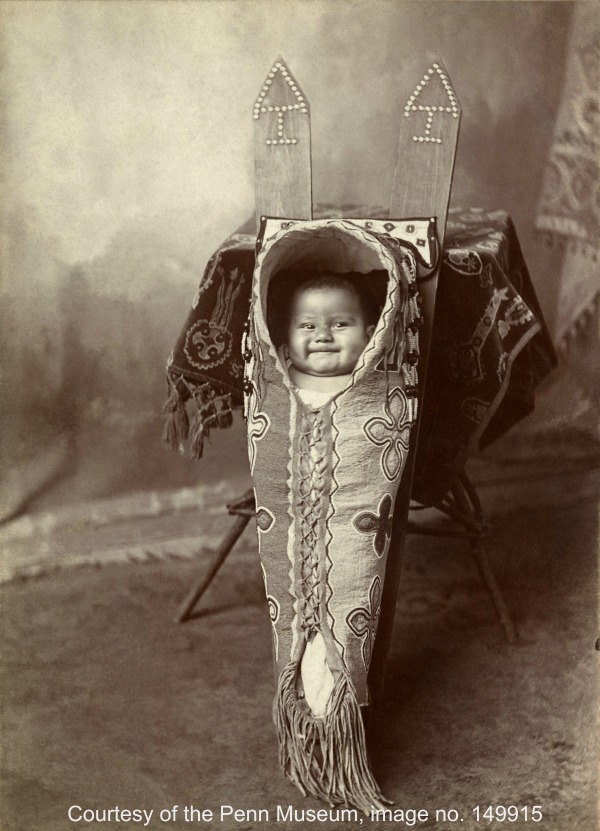
Baby Care in Early America
From the Colonial times until the late 1800’s, the task of diapering a baby remained virtually unchanged for American mothers. Diapers were made from cotton, muslin, flannel and linen. This was a good project to work on during those nine long months of pregnancy, and a useful way to re-purpose worn-out clothes and linens.
Because they were handmade, there was no pre-determined shape; they might be squares, rectangles or triangles and would be fastened on with buttons, sewn-on ties or straight pins (you can actually still buy “tie on” cloth diapers today). Wool covers were sometimes used, but generally babies wore only the diaper and were changed frequently.
Diaper rash would be treated with burnt flour or powdered vegetable sulfur.

Trade was brisk in the American colonies, affording women several options. They could purchase yards of special cloth diapering fabric at local shops. It was typically made of imported linen or muslin. Because they were still tied closely to England, Colonial Americans referred to diapers as napkins or clouts. Wool covers were called pilchers. You can see a napkin and pilch on a doll here.
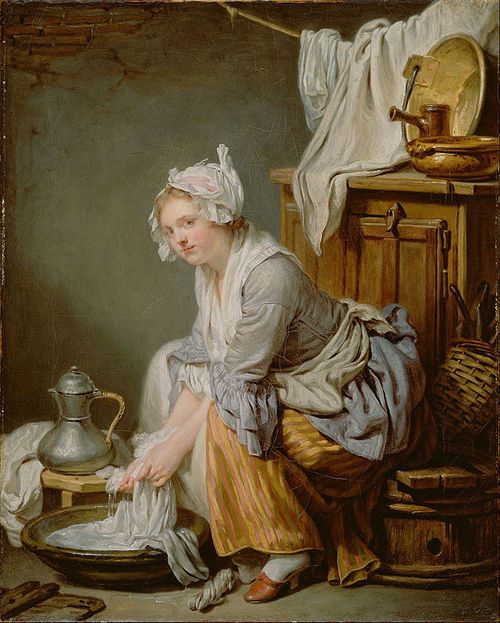
The Laundress by Jean-Baptiste Greuze (1761)
Women who went West as pioneers carried on the same diapering practices, although they wouldn’t have had as many choices, unless they brought a fancy layette with them from back East.
What About Diaper Laundry?
What was done with dirty diapers? It depends on how close to wash day you were! Mothers usually set aside a day or two each week to tend to the family’s laundry, since water was scarce and the work was taxing. So quite often, mother would simply rinse and ring out the wet diapers and hang them to dry; sometimes they were used again.

Although it offends modern sensibilities (and noses), urine was thought to be useful as both a disinfectant and stain remover (thanks to the ammonia). Our ancestors felt no sense of urgency about laundering a wet diaper. The smell of dirty diapers drying by the fireplace wasn’t too pleasant in the winter, but I’m sure the family just accepted it as a necessary reality. And I’m pretty sure it prompted mothers to encourage early potty-training! Young children, no matter their sex, wore gowns that opened at the bottom for frequent, easy changes.
Soiled diapers would be scraped, rinsed and set aside for washing.
Getting any type of laundry clean in the old days was a chore. After heating large amounts of water (on a stove or open fire) that had to be lugged from a well or spring in big buckets, clothes were sorted into piles. Then the long process of scrubbing and rinsing commenced, and lye soap was not kind to your hands.
Although upper-class women would have had the benefit of housemaids to relieve them of the task of diaper laundry, the process was still virtually the same no matter who was doing it. But it was not uncommon for even a mother of poor or modest means to hire a local girl or woman to help out when a new baby arrived. Famed author Laura Ingalls Wilder did this when Rose was born on the Dakota prairie.
An understanding husband could help with the washing, too, in a pinch!

Ben Leeson and his wife, circa 1901, source unknown
A New Century, and New Innovations
In the late 1880’s, diapering started to change. All-cotton cloth diapers were mass-produced and safety pins appeared on the scene. Mothers were encouraged to sanitize diapers by boiling them before re-using.
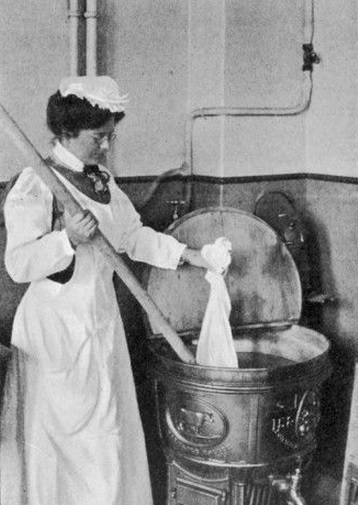 Detail of image at allposters, used with permission
Detail of image at allposters, used with permission
Diapering got another welcome boost in the 1940’s and 50’s when washing machines became more widely available and Curity introduced padded cotton prefolds. With absorbent layers pre-sewn inside, folding was much quicker. But even with modern innovations on the market, a good number of mid-century housewives continued to sew diapers and covers at home.

Disposables and More!
But one thing hadn’t changed. Mothers were still doing a lot of washing because diaper fabrics still weren’t as advanced (and absorbent) as they are now. During and after World War II there was not only a shortage of cotton; changing times resulted in an unfortunate flood of women into the workforce. There was less time for housework, and that meant less time for cloth diapers. American mothers were looking for innovation and convenience. Consequently, it was during and after the war that two big time-savers hit the scene: diaper washing services and disposables!
PauliStróm in Sweden invented the first throwaway, made of paper, in 1942. More innovation quickly followed, with Valerie Gordon’s “Paddi” (1947), crafted from nylon parachutes, cotton wadding and wool.
One especially prolific inventor, with 20 patents to her credit, was a housewife named Marion Donovan. Her “Boater” (patent filed in 1949, granted in 1950) was a reusable cover using shower curtain material as the waterproof barrier and innovative plastic snaps.
Following that, the Safe-T Di-Dee diaper was invented by Sybil Geeslin in 1950. It was preformed and also utilized snaps. After the patent was sold, this design was marketed as the Keystone Safe-T Di-Dee Diaper.
But despite huge progress in the design and performance of washable diapers, disposables had become the wave of the future, boasting four major selling points: (a) convenience, (b) absorbency, (c) trim fit, and (d) a lower incidence of diaper rash. In 1951, Pampers produced its first disposable diaper, complete with a flushable insert. In 1959, velcro appeared on the scene, first used by Riegel.
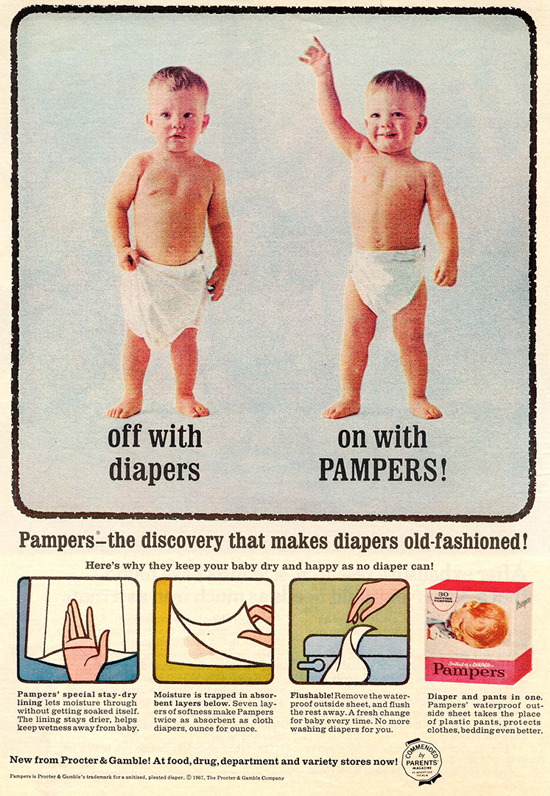
Pampers Ad, circa 1967, courtesy of FirstVersions.com
As you would expect, cloth diapers fell out of favor, but began to make a slow resurgence from the 1980’s onward, thanks to environmental, health and financial concerns. Some of the early innovators hail from Canada; Kushies designed a cotton form-fitted diaper in 1989, Bummis launched one of the first “modern” waterproof diaper covers in 1987, and Motherease followed with its own fitteds and covers beginning in 1991.
The Modern Cloth Diaper
Brands like Fuzzibunz (who introduced the modern “pocket” diaper in 1999) helped to make cloth more accessible and less daunting to American families. The revolutionary one-size bumGenius, still a perennial top-seller, made its debut in 2006.
More styles followed: All-in-One’s and All-in-Two’s, Hybrids, and Hybrid Fitteds. Cloth diapering wasn’t just a movement – it was a trend. And mothers were making it fun (and social) with chat groups, diaper parties, giveaways, and constant clamor for new prints and colors.
Mothers (like me) who cloth diaper today have a much easier time of it. Modern diapers are super absorbent and easy to launder. I don’t deal with issues like boiling and hauling water for wash day (although I do know how to hand wash now, thanks to the encouragement of Kim at Dirty Diaper Laundry). PS: She also has a complete diaper timeline here.
But after doing all this research, I still have a few unanswered questions:
- Did early American mothers try to make diapers prettier by dying them or using colored ribbons, buttons, etc?
- How common was diaper rash before disposables were introduced?
- Where were dirty diapers stored until wash day?
Let me know if YOU know the answers!
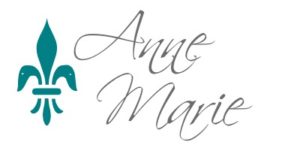
Other sources consulted but not cited or linked to:
All photos are either in the public domain or are used with permission.
The Diaper Jungle. The History of Diapers – Disposable and Cloth, http://www.diaperjungle.com/history-of-diapers.html
Archives Center, National Museum of American History. Marion O’Brien Donovan Papers, http://amhistory.si.edu/archives/d8721.htm
The Colonial Williamsburg Official History and Citizenship Site. Fashions of Motherhood, http://www.history.org/history/clothing/women/motherhood.cfm
Wikipedia. Diapers, https://en.wikipedia.org/wiki/Diaper
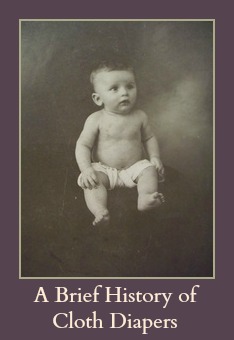
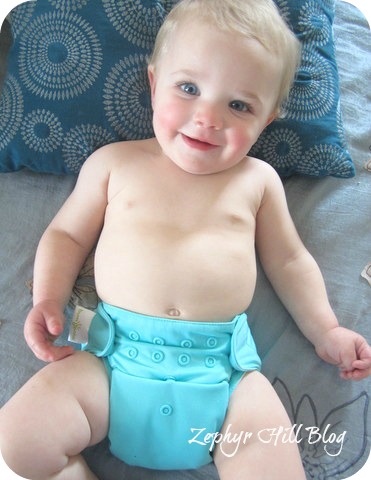
so interesting! thanks for the history lesson
I loved reading this. It also came on the heels of staying with my grandparents for a couple days. When she saw my daughter’s best bottom snap-in cloth diaper she couldn’t believe it. She went around telling everyone how spoiled mother’s are these days and how wonderful the diaper was. It made me smile.
Hi Sara! I bet she WAS impressed by the Best Bottoms. They are a truly modern marvel if you compare to simple squares of cotton and pins. Thanks for commenting! Anne
In the early 60s in Canada
Diaper rash was relatively common and was treated with zinc ointment. Often, in summer, a sore bottom went bare in the sun, outside on a blanket.
Diapers were stored in the bathroom in a lidded diaper pail filled with water and a little vinegar.
Hi Anne,
This is a great article, I enjoyed reading it. I cloth diapered my 9 kids and found it to be a joy. It felt really good to put the soft, cloth diaper on my little ones’ bums.
Thanks for encouraging others to do the same.
Rosanne
I agree, Rosanne! If I were a baby myself, I’d definitely choose a soft, natural diaper! Thanks for commenting. Anne
Anne
Since I make my own diapers, when they wear out I have to make new ones, but they are so fun to make I don’t mind. Interesting to see that they didn’t have patterns, I guess it was something I never really thought about.
That’s so wonderful you make your own diapers, Beth! It’s definitely a dream of mine. I do have a sewing machine but am a novice and only work on very simple project when time allows. Anne
Anne, you`ve done your homework here! It`s definitely hard to think of a time when diapers didn`t get washed every day! It always makes me smile when people ask me about diaper pins… we`ve never pinned anything because cloth diapers truly are as easy to put on as disposables these days! Great article!
Thanks! And you’re right about pins. I only used a diaper pin one time and that was when I first started diapering and that’s because I thought I had to. LOL I never even took the other pins out of the package after I discovered you could trifold a diaper and just lay it in a cover. Anne
I wish that my great-grandma was still alive. I would love to show her how we do it nowadays. I wonder what she would think of the fact that I just tie dyed my flats LOL
While I was doing my research I actually wondered why mothers never dyed their diapers, just for fun, you know?
Came to the link via our FB group. This is very interesting. I think I always assumed there were pins. I obviously didn’t think about it. It’s funny how my grandmothers generation loves my cloth diapers but my parents generation all think its gross. Only a generation of unhealthy habits away and look at all the health issues that have come to be.
Melanie, what you said is so insightful. I also find that the older generations do have good memories of cloth diapers, but not so much the mothers who grew up in the 60’s and 70’s. I have a lot of grandmothers and great-grandmothers entering my cloth diaper giveaways!
Hi, Anne,
Thank you so much for this article. I found it very informative and useful, too. My sixth-great-grandparents made the arduous 300- mile trek from the Shenandoah Valley, VA to what is now eastern Tennessee, with six children under the age of ten, no less! I wondered how this would work out since the youngest at that time was about 20 months old. Finding out what kind of diapers were used, and what they called them helps a great deal. Since I’m busy writing a fictional account of their, this has helped a great deal in my understanding.
April, I so glad this was able to help you get an idea of historical diapering practices for your story. Sounds like a fascinating account! ~Anne
Interesting indeed. I know my Mom cloth diapered us, but I think she also used disposables. None of my Grandparents are around to ask of their experience. =( My husband’s Mother thinks it’s gross and that I’m ‘weird’ for doing anything but disposables. She tried cloth on her firstborn but said it gave him a horrible rash. So, that’s all it took to turn her away from cloth.. forever I guess. Then again, she also doesn’t understand why anyone would have more than the 2 children she had. (eye roll)
Wish my grandparents were here so I could ask, too! ~Anne
fantastic article! Read every word…. Which doesn’t happen often.
Hi Anne! I have enjoyed your Brief History of Cloth Diapers and I’m citing your page in a research paper I’m working on. In order to fill in my citation I need a little info that I can’t find on this page. Would you mind sharing with me? Is your last name Zephyr? And I’m not sure if I understand the web address but I think it means you published it in Aug of 2012. Is that correct? Do you know the exact date? Last question. Is the name of your web site Zephyr Hill? If you are open to sharing this info but don’t feel comfortable posting it on here I understand. You’ll have my email if that would work, Thanks for sharing your Blog
I will be glad to email all the info you need, Heather. Thanks for visiting! ~Anne
Trying to diaper a Baby Jesus for Christmas Pagent. How did they keep diapers on before pins? I read ties but that seems so dangerous. I was thinking a big triangle tied in front but that seems uncomfortable for baby? Triangle seems best idea. Oil cloth “plastic/vinyl pants”?
Tawnya
Dadw City, FL
Hi Tawnya – depending on the time period and the culture, there were different ways to keep the diaper on, including ties, buttons or simply wrapping and tucking the fabric. What a neat idea to put cloth on Baby Jesus for a pageant! ~Anne
My grandmother used to tell me of her cloth diapering days. She had a wooden box that had been painted. That box belonged to her oldest son, it was his wooden diaper box, made by his grandpa, and used to hold his cloth diapers in. She would wash them then hang them on the line to dry. Once dry, she folded them and stored them in that box. My grandmother’s mother used to call cloth diapers dipies.
That is a heartwarming memory for sure! Thank you for sharing, Crystal. ~Anne
Dear Anne Marie,
Thank you for reading my question.
I read your blog about cloth diapers because I am looking for a photo of a baby in cloth diapers from around 1950. Via google I came to your blog.
For our veterinary practice I am writing a request for second hand, white, cotton diapers. We use them in our practice (sterilized) in our OR and for example for patients with severe wounds. The cloths are durable, soft enough, yet tough and absorbing enough.
To illustrate which diapers I mean (and not the modern all colored diapers) I wanted to add an old fashion photo.
My question is: can I use your black and white photo of the boy in a diaper? The one which is on the top of your “Brief history of cloth diapers” blog?
Thank you in advance.
Kind Regards,
Dr Leonie Gooijer, DVM, MSc.
Veterinarian Spierdijk, the Netherlands
Hi Dr. Gooijer! It’s been so long since I published the post, that I can’t remember the name of the website that I obtained permission from for the black and white photo. So unfortunately it is not mine to share. However, you might contact the owner of this photo, as it shows a baby in the old fashioned white cotton diaper: https://pixels.com/featured/1960s-baby-wearing-cloth-diaper-sitting-vintage-images.html Thanks for stopping by! ~Anne Marie
Thank you very much, Anne Marie. For your answer aswell as the lead for the owner of the photo. I will look into it. Thanks again.
Leonie
What an excellent, well-researched article! I will definitely be referencing this on my vlog, The History of #Momlife! Well done!
I appreciate the share, Crystal, and will definitely check out your vlog! ~Anne Marie
This was very useful for me as I have a series of Victorian mysteries which progresses through the lives of the characters. At the moment my characters have a six month old baby.
I’m also old with a daughter born in 1973. Back then I used cloth diapers with safety pins. We rinsed them out and left them soaking, and washed them once a week. They used to smell. My daughter potty trained herself by fifteen months. Later children who wore disposables took longer to train. When I was a child in the fifties and got my first period it was the same. I used a folded piece of cloth attached by safety pins to a belt and left the used pads soaking in the washroom in cold water. My mother washed them out at the end of the week.
A stinkier world back then, but no one realized that at the time!
Thanks for sharing your experiences, Wendy! That was a little history lesson in and of itself. ~Anne Marie
You kind of missed, intentionally or not, a major revelation in the evolution of diapers when in 1950, my mother Sybil Geeslin (Mrs. RG Geeslin) invented the Keystone Safe-T-Ditee Diaper. The first pinless diaper that used snaps in place of safety pins. I as an infant and toddler was the incentive for that invention. You might check out https://www.diaperjungle.com/pages/history-of-diapers/. Plus I have the newspaper clippings from local media about the amazing new product.
Thanks, didn’t know about this one and will add to the post! – Anne Marie
IN the 1960s when I helped my mom with my younger siblings, we used cloth diapers and diaper pins. Wet diapers were placed in the diaper pail, which had a liquid solution in it of some sort to mask the odor. Possibly Lysol? Dirty diapers had to be rinsed in the toilet to get rid of the soil and then placed in the diaper pail. If you had a washing machine, baby laundry generally had to be washed and sanitized every day or two, and hung on the line to dry in the sunshine. Some people used a diaper service.
Plastic pants were used over the diaper to keep the wetness from leaking all over everything, although it wasn’t fool proof.
I remember my poor sisters getting diaper rash on their fair, delicate skin. We tried so hard to keep them dry as possible, even letting them go bare at times to give the rash a chance to dry out. With my youngest sister my mom tried using the early version of Pampers if we were traveling, but they didn’t keep her very dry compared to the disposables of today.
By the time I had my children in the 80s and 90s, disposables kept baby very dry. Rarely ever got a rash. However I still bought cloth diapers because, besides being a back-up in case I ran out of disposables, they were wonderful to use for so many things…such as burp cloths.
We used cloth for my little brother in the 80’s and it was much the same as your experience! Some mothers used just water in their wet pail, but some added things like vinegar or baking soda or borax. Like you, I appreciate the convenience of disposables, but also love the way cloth diapers don’t just serve as a back-up and save money, but they can be repurposed! – Anne Marie
That is fascinating. I never knew much about cloth diapers before today!
Diapers have come a long way. So glad that I was able to use disposables.
Thank for sharing wonderful information! We have a new diaper brand name, Nubaby premium baby pants and diapers,. Designed for toddlers they are light and soft. Discover the ultimate in baby care with our premium diapers!
Hi there! Feel free to use the contact form to send me more info. Thanks! Anne Marie
Thank you for sharing wonderful information we had new diaper brand name Nubaby premium baby pants and diapers designed for toddlers are light and soft. Discover the ultimate in baby care with our premium diapers.
It’s fascinating to think about how the earliest settlers in America, especially Native American tribes, approached diapering long before modern disposables or even cloth diapers were invented. Each tribe had its own unique methods, often influenced by their environment. In warmer climates, babies could go without pants and potty train early, which makes sense in such a practical, natural way of life. Using absorbent materials like moss, grass, or weeds as makeshift diapers was clever, as these materials would break down and decompose, leaving no waste behind. It’s also interesting that they incorporated plants like sphagnum moss and juniper bark, which not only absorbed moisture but had skin-soothing properties. In colder areas, like with the Eskimos, animal skin was used to make covers, which sounds both functional and resourceful. The sealskin baby pants with ties are such a unique and historical example of how they adapted to their environment and materials. It’s amazing to see how practical and sustainable these early methods were!
Interesting to note that cloth diapering has evolved so much over the years. Cloth diapered from birth through age 10. The last years were worn for bedwetting but still used cloth.